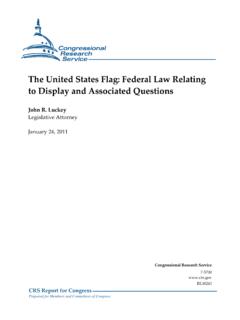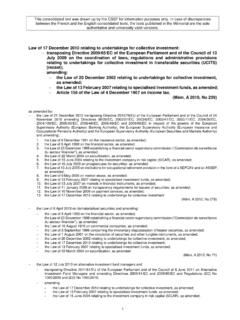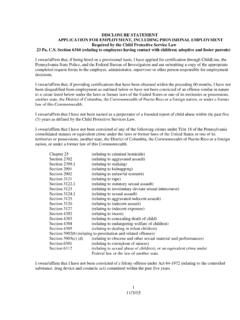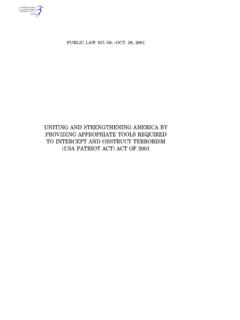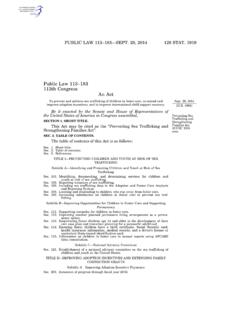Transcription of Public benefit: Analysis of the law relating to ... - GOV.UK
1 1 of 22. Public benefit Analysis of the law relating to Public benefit This Analysis is designed to be read in conjunction with the guidance issued by the Charity Commission under section 17 (1) of the Charities Act 2011 in pursuance of its Public benefit objective. Contents Introduction 3. Charity law prior to the Charities Act 2006 3. The Charities Acts 2006 and 2011 5. Key concepts 5. Continuity of the law 5. Purposes and activities 6. No presumption of Public benefit 6. The Public benefit requirement', the Public benefit objective' and the Commission's Public benefit guidance 6. The scope of the Commission's Public benefit objective 7. Public benefit not a static concept 7. Empirical development of the law 8. Fiscal privileges 8. Identifying the purposes of an institution 8. Public benefit as integral to a charitable purpose 9. The two aspects of Public benefit 9.
2 The benefit' aspect 10. A purpose must be beneficial 10. How benefit is established 11. Subjective beliefs of donors are not relevant 12. Benefit and detriment 12. Public benefit: Analysis of the law relating to Public benefit September 2013 (new format February 2017). 2 of 22. Political purposes 12. Some issues non-justiciable 13. The Public ' aspect 13. The benefit must be to the Public in general or a sufficient section of the Public 13. Applying the rule that, to be charitable, a purpose must be for the benefit of the Public in general or a sufficient section of the Public 14. Differences between the descriptions of purposes 14. The prevention or relief of poverty 15. Capricious class 15. Beneficial class defined by geographical area 16. Classes linked by a personal nexus 16. Mutual benefit 16. Recreational charities 16. Purposes outside England and Wales 17.
3 Purposes which discriminate 17. A charitable purpose cannot exclude the poor 17. Incidental personal benefits 18. A charitable purpose may benefit individuals 18. Benefits to individuals must be no more than incidental 19. Public benefit and running a charity 19. The duties and powers of charity trustees 19. The duty to further the purposes of the charity for the Public benefit 20. When charity trustees are in breach of duty 21. Altering purposes 21. Charging for services 21. Conclusion 22. Public benefit: Analysis of the law relating to Public benefit September 2013 (new format February 2017). 3 of 22. Introduction 1. The Charities Act 2011 provides that it is a requirement of a charitable purpose that it is for the Public benefit. It defines this as the Public benefit requirement'. The Act gives the Charity Commission an objective of promoting awareness and understanding of the operation of the Public benefit requirement, and requires the Commission to issue guidance in pursuance of that objective.
4 2. The Commission first issued guidance in pursuance of its Public benefit objective in January 2008. It has now revised and re-issued its general Public benefit guidance. In doing so, it has taken account of recent changes in the law and decisions of the courts and tribunals (including the consideration by the Upper Tribunal of its previous guidance in R (Independent Schools Council) v Charity Commission1), experience of the use of its original guidance, and the responses to a Public consultation on a draft of the revised guidance. 3. This Analysis of the law is intended to provide a statement of the law on which the Commission's statutory guidance is based. It is not intended to be an exhaustive statement of the law. It does not itself form part of the Commission's Public benefit guidance (ie the guidance to which charity trustees must have regard when exercising any powers or duties to which the guidance is relevant).
5 4. This Analysis summarises the Commission's understanding of the law as at June 2013. Charity law prior to the Charities Act 2006. 5. The legal meaning of the term charity' does not correspond to its popular meaning2. The origin of the modern legal concept of charity is the preamble to the Statute of Charitable Uses 16013. The courts recognised the purposes listed in that preamble as charitable purposes. The courts also recognised as charitable other purposes which were analogous to those listed in the preamble, or which were analogous to those recognised in previous decisions of the courts, all such purposes being described as within the spirit and intendment' of the preamble. What had to be regarded was: not the wording of the preamble itself, but the effect of decisions given by the courts as to its scope, decisions which have endeavoured to keep the law as to charities moving according as new social needs arise or old ones become obsolete or satisfied 4.
6 1 [2012] Ch 214. 2 Commissioners for Special Purposes of Income Tax v Pemsel [1891] AC 531; the words charity' and charitable' bear, for the purposes of English law and equity, meanings totally different from the senses in which they are used in ordinary educated speech or, for instance, in the Authorised Version of the Bible IRC v McMullen [1981] AC 1 at 15 (Lord Hailsham). 3 See for example Morice v Bishop of Durham (1805) 10 Ves Jun 521 at 541 (Lord Eldon) where there is a gift to charity, in general, whether it is to be executed by individuals, selected by the testator himself, or the King, as parens patri , is to execute it it is the duty of such trustees, on the one hand, and of the Crown, upon the other, to apply the money to charity, in the sense, which the determinations have affixed to that word in this Court: viz. either such charitable purposes as are expressed in the Statute (stat.)
7 43 Eliz. c. 4), or to purposes having analogy to those.. 4 Scottish Burial Reform and Cremation Society Ltd v Glasgow Corporation [1968] AC 138 at 154E (Lord Wilberforce). Public benefit: Analysis of the law relating to Public benefit September 2013 (new format February 2017). 4 of 22. 6. In Income Tax Commissioners v Pemsel5 Lord Macnaghten adopted the following four-part classification of charitable purposes: 'Charity' in its legal sense comprises four principal divisions: trusts for the relief of poverty; trusts for the advancement of education; trusts for the advancement of religion; and trusts for other purposes beneficial to the community, not falling under any of the preceding heads.. 7. This classification was used as the basis for the subsequent development of the law. 8. It was always implicit in the concept of charity that, to be charitable, a purpose had to be for the Public benefit.
8 During the 20th century, decisions of the courts made clear that Public benefit was an integral part of every charitable purpose, and clarified various aspects of the concept of Public benefit. 9. It was not sufficient for a purpose to be charitable that it was for the Public benefit. For a purpose to be charitable, it was also necessary for it to fall within the spirit and intendment of the preamble. Thus in Attorney-General v National Provincial & Union Bank of England6 Lord Cave LC, referring to the fourth of Lord Macnaghten's categories, said: Lord Macnaghten did not mean that all trusts for purposes beneficial to the community are charitable, but that there were certain charitable trusts which fell within that category; and accordingly to argue that because a trust is for a purpose beneficial to the community it is therefore a charitable trust is to turn round his sentence and to give it a different meaning.
9 So here it is not enough to say that the trust in question is for Public purposes beneficial to the community or for the Public welfare; you must also show it to be a charitable trust.. 10. The provision of housing in circumstances not limited to the relief of charitable need7 is an example of a purpose which was held not to fall within the spirit and intendment of the preamble, and hence not to be charitable. 11. In National Anti-vivisection Society v Inland Revenue Commissioners8 Lord Wright said: The test of benefit to the community goes through the whole of Lord Macnaghten s classification, though as regards the first three heads, it may be prima facie assumed unless the contrary appears.. 12. As a result it was widely considered that there was a presumption that a purpose that fell within the first three heads was for Public benefit although views differed as to the nature and effect of such presumption.
10 This aspect is considered further in paragraph 26. 5 [1891] AC 531 at 583. 6 [1924] AC 262 at 265. See also Williams' Trustees v Inland Revenue Commissioners [1947] AC 447; Helena Partnerships Ltd v Commissioners for Her Majesty's Revenue and Customs [2012] EWCA (Civ) 569, [2012] PTSR 1409, and the further authorities there cited. 7 Helena Housing Ltd v Commissioners for Her Majesty's Revenue and Customs [2012] EWCA (Civ) 569, [2012] PTSR 1409. 8 [1948] AC31 at 42. Public benefit: Analysis of the law relating to Public benefit September 2013 (new format February 2017). 5 of 22. The Charities Acts 2006 and 2011. Key concepts 13. Part 1 of the Charities Act 2006, which came into force on 1 April 2008, and was consolidated as Part 1. Chapter 1 of the Charities Act 2011, enacted a statutory definition of charity'. For the purposes of the law of England and Wales, the term charity' is defined by section 1 of the Charities Act 2011 as: an institution which (a) is established for charitable purposes only, and (b) falls to be subject to the control of the High Court in the exercise of its jurisdiction with respect to charities.










